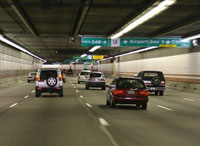Settlement reached over Big Dig fatal accident
A company blamed in the deadly ceiling collapse of a Big Dig tunnel last year has agreed to give the family of the woman killed not only $6 million, but something they really want: answers.

Still, representatives of the widower and children of Milena Del Valle said Tuesday the family needs even more information on the series of events, decisions and failures that ultimately caused 26 tons of concrete ceiling panels to come crashing down on her car in Big Dig tunnel.
The 39-year-old mother of three was crushed on July 10, 2006, as she and her husband drove through an Interstate 90 connector tunnel. Her husband, Angel Del Valle, escaped with minor injuries.
On Monday, a Brewster, N.Y., firm that supplied the epoxy agreed to settle a lawsuit filed last year by Del Valle's family, capping weeks of confidential negotiations, the AP reports.
Big Dig is the unofficial name of the Central Artery/Third Harbor Tunnel Project , a megaproject that rerouted the Central Artery, the chief controlled-access highway through the heart of Boston, Massachusetts, into a 3.5 mile (5.6km) tunnel under the city. The project also included the construction of the Ted Williams Tunnel (extending Interstate 90 to Logan International Airport), the Zakim Bunker Hill Bridge over the Charles River, and the Rose Kennedy Greenway in the space vacated by the previous I-93 elevated roadway.
Initially, the plan was also to include a rail connection between Boston's two major train terminals. The official end date of the project is December 31, 2007, when the partnership between contractor Bechtel/Parsons Brinckerhoff and the Massachusetts Turnpike Authority ends.
A fatal accident raised safety questions and closed part of the project for most of the summer of 2006. On July 10, 2006, a concrete ceiling panel weighing 3 tons (2.7 t) and measuring 20 by 40 ft. (6.1 by 12.2 m) fell on a car traveling on the two-lane ramp connecting northbound I-93 to eastbound I-90 in South Boston, killing Milena Del Valle, who was a passenger, and injuring her husband, Angel Del Valle, who was driving. The collapse also contributed to the death of another person, a heart attack victim who died en route to a hospital when his ambulance was caught in a resulting traffic jam two weeks after the collapse. On September 1, 2006, one eastbound lane of the connector tunnel was re-opened to traffic.
Following extensive inspections and repairs, Interstate 90 east and west bound lanes reopened in early January 2007. The final piece of the road network, a high occupancy vehicle lane connecting Interstate 93 north to the Ted Williams Tunnel, was reopened on June 1, 2007.
On July 10, 2007 after a lengthy investigation, the National Transportation Safety Board found that epoxy glue used to hold the roof in place during construction was not appropriate for long term bonding. This was determined to be the cause of the roof collapse. The Power-Fast Epoxy Adhesive from Powers Fasteners used in the installation was designed for short term loading, such as wind or earthquake loads, not long term loading such as the weight of a panel.
Source: agencies
Subscribe to Pravda.Ru Telegram channel, Facebook, RSS!





